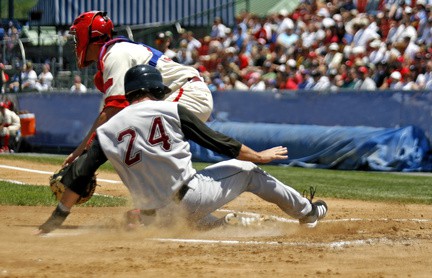One of the most basic principles of photography is to get the photo in sharp focus. It makes sense, then, that there is nothing harder and more frustrating than trying to shoot a moving target!
This problem is never more obvious than in sports photography. Athletes dart around the playing field with lightning quick moves – a juke left, a shift to the right, and all you as the photographer have to show for it is a blurry photo. But then you see the sports magazines with awe-inspiring photographs. How do they do that?
Let’s begin with the basics: know your camera. Know where all the dials and buttons are without fumbling for them. Know your camera functions so well you can change settings in a dark room. If you are on the sidelines trying to figure out how to change the f/stop, the big moment of the game will come and go and you'll have nothing to show for it but frustration.

Check your camera manual ahead of time and have it set to continuous or burst mode. Press down the shutter and fire off shots in rapid succession without ever taking your figure off the shutter. The camera sounds like a machine gun. This is where frames per second numbers become relevant. The higher the frames per second rate, the better chance you have of capturing a tack sharp sports photo somewhere in the sequence. Burst mode can be a drain on your battery, so make sure you have extras handy and fully charged.
Most DSLR’s have four focusing modes – manual, auto, single or continuous. Select C on a Nikon for AF-Continuous – that’s where the camera constantly tracks focus as the subject moves. (On a Canon it’s called AI Servo or AF.) As soon as you press down on the shutter, the camera begins to focus. As it detects the subject’s movements, it keeps refocusing. You still might get some photos out of focus, but one of them should be tack sharp. And switch from multi-point to single point focusing. This tells your camera to focus on what is in the center rather than trying to keep everything in the frame sharp. You tell the camera what to focus on (such as an athlete’s eyes) rather than having the camera make that decision.

Also, on Canon cameras learn to use the optional back-button focus. This separates the focus function from the shutter function. When you want use auto focus, press the “*” key with your thumb. When you have the luxury of setting your focus ahead of time take your thumb off the button (for example, when taking photos of baseball batters or pitchers, or other situations where you can anticipate where the action will be).
With my T3i autofocus may as well be called “random focus” when shooting moving subjects. My sports phoography has improved immeasurably since i was turned on to this Canon option!
While this article is full of good advice I have to seriously disagree with the suggestion to push down on the shutter button and hope for the best in capturing the action. that is just about a guarantee of actually missing the shot.
How stacked are the odds against you. Lets assume you have a camera that can do 8 frames a second. You are shooting at 1/500 of a second. So in one second you will have captured 8 images for a total of 8/500 of a second. That leaves 492/500 of a second that you missed and the odds are that the moment you wanted to capture happened in one of those 492/500s of a second. The slower your frame rate, the less likely you are to catch the moment you are looking for with spray and pray.
If you want to consistently come back with the shots then you need to do two things. Understand the game, and learn to time your shots. There is no shortcut for this.
Quick question: I use my (Nikon) 70-200mm VRII (full frame lens) on a crop sensor D7000 (for the extra reach) when I shoot sports photography. I am noticing consistently that my auto-focus is not matching up to what is actually being in focus (no matter which or how many continuous servo points I have switched on). I have also tried to use just the single point continuous, with the same result. Is this problem because I am trying to us a full frame lens with a crop sensor body (like the focus points don’t match up or something?)?. Does my body need to be recalibrate for a full frame lens??
Hey Oscar, I had the same setup before and I used the D7000 with my nikon 70-200 2.8 and found that I was getting some decent shots but not what I really wanted. Unfortunately I’m not a pro photographer but I can tell you that I spent the money and upgraded my body to the D500 and I noticed a night and day difference in the sharpness of my photos. The D500 also goes about 10 fps compared to the 5 or 6 from the D7000. I’ve found that I also switch to full Manual mode and the D500 allows my ISO to go up much higher for sports at night. Lately I have been shooting baseball at night and am very pleased with the outcome of my photos. I’ve been shooting at 2.8-3.5 for my f stop and 1/800 to 1/1000 with my ISO usually around 8000 and I feel like the photos have been coming out really nice! I also use the group focus on the D500
I use the same technique for indoor volleyball? I can set the focus on one player and it doesn’t matter if another player enters or crosses through my line of sight. My focus never changes and I don’t miss shots waiting on the camera to refocus on my intended subject. I capture so many more shots this way.